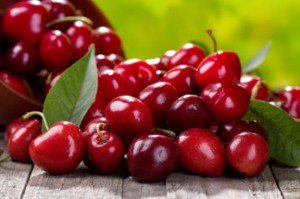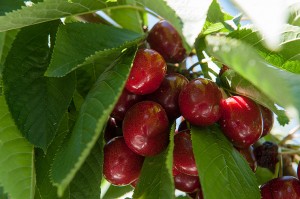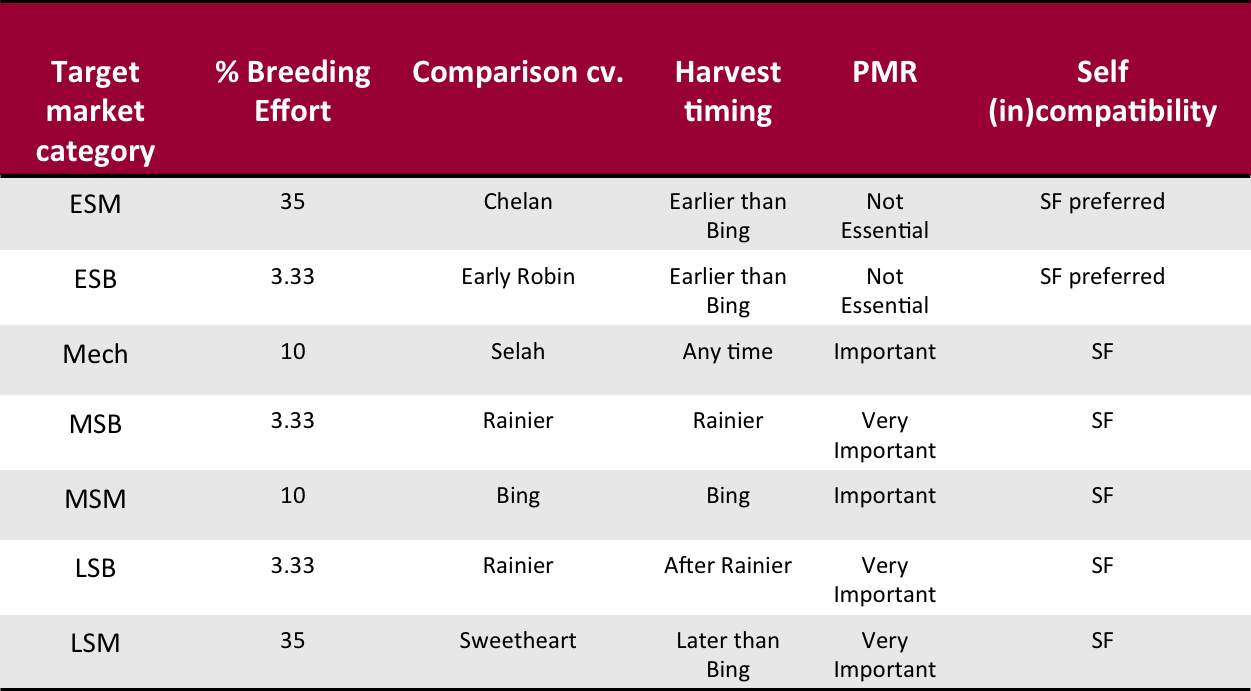 The goal of the Washington State University sweet cherry breeding program is to develop new high quality sweet cherry cultivars with high consumer appeal suitable for growing in the PNW regions of the USA. The project has 6 main breeding objectives each of which represents new cultivar targets or ideotypes for different market segments. The program has recently evolved into 3 phases. Phase 1 includes making crosses, planting own-rooted seedlings in the field and evaluating the fruit, Phase 2 includes replicated trials of grafted advanced selections on 4 locations both on-station and on-farm in WA(3 sites) and OR(1 site) and Phase 3 contains replicated trials of elite selections on grower-cooperator orchards in WA(5 sites) and OR(1 site plus a future site) prior to release. The genotypes in Phases 2 and 3 represent potential new cultivars that fit into the desired target market segments. Of particular interest is the genotype in Phase 3 which belongs to the early ripening market class. This advanced selection has similar harvest timing to the current market leading cultivar in that category, i.e., ‘Chelan’. In addition, the fruit is larger and firmer than fruit from ‘Chelan’ without GA application and also, it is self-fruitful and may not require bees for pollination. In phase 2, there is an advanced selection that fits into the target market category for mechanical harvesting. This genotype is later, firmer and has a lower pedicel retention force than ‘Selah’, the current leading cultivar in that market class. Growers have indicated interest in testing this selection in planar training systems to assess yield potential and mechanical harvestitibility.
The goal of the Washington State University sweet cherry breeding program is to develop new high quality sweet cherry cultivars with high consumer appeal suitable for growing in the PNW regions of the USA. The project has 6 main breeding objectives each of which represents new cultivar targets or ideotypes for different market segments. The program has recently evolved into 3 phases. Phase 1 includes making crosses, planting own-rooted seedlings in the field and evaluating the fruit, Phase 2 includes replicated trials of grafted advanced selections on 4 locations both on-station and on-farm in WA(3 sites) and OR(1 site) and Phase 3 contains replicated trials of elite selections on grower-cooperator orchards in WA(5 sites) and OR(1 site plus a future site) prior to release. The genotypes in Phases 2 and 3 represent potential new cultivars that fit into the desired target market segments. Of particular interest is the genotype in Phase 3 which belongs to the early ripening market class. This advanced selection has similar harvest timing to the current market leading cultivar in that category, i.e., ‘Chelan’. In addition, the fruit is larger and firmer than fruit from ‘Chelan’ without GA application and also, it is self-fruitful and may not require bees for pollination. In phase 2, there is an advanced selection that fits into the target market category for mechanical harvesting. This genotype is later, firmer and has a lower pedicel retention force than ‘Selah’, the current leading cultivar in that market class. Growers have indicated interest in testing this selection in planar training systems to assess yield potential and mechanical harvestitibility.
DNA information is routinely used in the program to improve breeding efficiency and reduce costs. Genetic tests for self-fertility and fruit size ensure that only parents with a high probability of producing large fruited and self fruitful progenies are used in crosses. The tests also help to eliminate inferior seedlings so only seedlings that have favorable alleles for desired traits are planted in the field. The latest innovation in the program is the implementation of bar coding to improve accuracy of tree labeling and data recording in the laboratory. We are making progress towards establishing marker-locus-trait (MLT) associations for other traits including fruit firmness, soluble solids content, flesh/skin color, titratable acidity, pedicel retention force, bloom date, maturity date and powdery mildew resistance. These MLT tags will be deployed once very reliable, robust genetic tests are available.
 Current Focus of the Cherry Breeding Program
Current Focus of the Cherry Breeding Program
The WSU sweet cherry breeding program continues to concentrate on finding improved cherry cultivars that will benefit both growers and consumers. Growers are looking for varieties that will extend their current early and late sweet cherry harvest windows. The new varieties need to be disease resistant (especially for powdery mildew), able to withstand the arid growing conditions in North Central Washington, and be capable of producing heat-tolerant fruit that will not easily crack in the rain. Growers are also looking for varieties that will do well in modern production systems that enable mechanical harvesting. Consumers want beautiful, delicious fruit with a stable shelf life. It is both challenging and time-consuming to find varieties containing all of the desired traits.
Currently, work is being done on the genetic control of the following traits: (* indicates known markers)
- Rain cracking
- Mildew infection
- Pitting
- Size *
- Firmness *
- Sugar *
- Flavor
- Acidity*
- Color*
- Harvest timing*
Two potential new varieties, R25 and R2, are currently in Phase 2 and Phase 3 of the research selection process, respectively. R25 is an early advanced selection, which ripens within 3 days of ‘Chelan’, and has a crunchy, firm texture. R2, a dark red variety, ripens several days after Chelan. See the Good Fruit Grower article for more information on these potential new varieties.
The WSU Breeding program also continues to preserve germplasm, and manage phenotype data on varietal selections currently in the testing phases. Work conducted during 2015 focused on orchard horticultural practices, trellis and netting trials, as well as irrigation systems.
The table below lists the sweet cherry breeding selection parameters and descriptors for the Pacific Northwest region.

Keys for table:
ESM = Early season Mahogany: ≧5 days before Bing
ESB = Early season Blush: ≧5 days before Rainier
Mech = Mechanical
MSB = Mid-season Blush: +/- 4 days of Rainier
MSM = Mid-season Mahogany: +/- 4 days of Bing
LSB = Late season Blush: ≦5 days of Raineir
LSM = Late Season Mahogany: ≦5 days of Bing
PMR = Powder mildew resistance
The table below gives the key harvest dates for comparison cultivars grown at different maturity sites

Additional Resources
Breeding the new cherry, S. Dininny, Good Fruit Grower, May 2016
Breeding better rootstocks, S. Dininny, Good Fruit Grower, May 27, 2016
New cherry varieties wanted urgently, G. Warner, GFG, May 2015.
Early cherry is on fast track, G. Warner, GFG, May 2015.
This article was updated by Tom Auvil, WFTRC and Wendy Jones, WSU Tree Fruit Extension, June 2016.
